A Day In The Life Of A Gobi Desert Nomad
If you truly want to disconnect from the world and reconnect with nature, this is the place to do it. There are not many places that still exist on earth that compare to the Gobi Desert’s vast remoteness. The word ‘Gobi’ means ‘large and dry’ or ‘waterless place’ in native Mongolian. This famous desert lives up to its name in more ways than one. The Gobi Desert nomads are among some of the most resilient and independent people in the world.
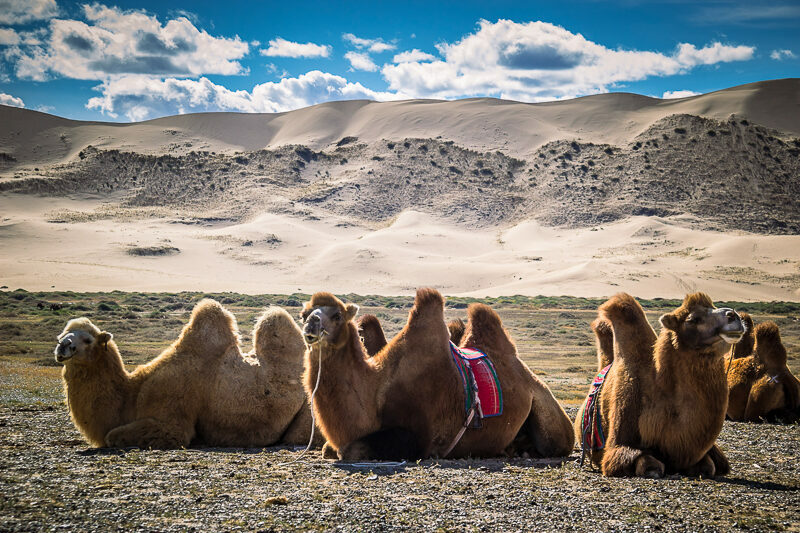
This vast desert is a harsh, raw and barren place. Famous for its soaring sand dunes, rocky landscapes and resilient people, visiting the Gobi is truly a once in a lifetime experience. The desert is a vast and arid region, which spans from the south of Mongolia to the northern reaches of China. This normally inhospitable landscape is actually known for its rare and unique animals, including black-tailed gazelles, marbled polecats, wild Bactrian camels, Mongolian wild ass and sand plovers. The area is also occasionally visited by snow leopards, brown bears, and wolves.
The desert is a sprawling patchwork of desert basins and mountain ranges. High winds pummel through this coarse landscape. Mongolians claim that when the winds whip across the dunes, that they’re singing to the people. The brilliantly star spangled night skies, silent remoteness and genuine people make the Gobi Desert a ‘must-see’ location.
The fifth largest desert in the world, The Gobi was described by one of the first Western explorers many years ago as “a waterless, treeless region that burns your skin in the summer and freezes you to the bone in winter”. Charming description! Temperatures do vary dramatically in Summer and Winter, ranging from -40C to 45C.

The Gobi gained international attention after dinosaur bones were discovered at the ‘Flaming Cliffs’. It was the first country to find fossilised dinosaur eggs, a fact that renders much pride for the Mongolian people.
Historically, the Gobi Desert played a significant role in the advancement of the great Mongol Empire, the largest continuous empire in history. With the notorious Genghis Khan at the reigns, the empire ruled the world in the 13th and 14th centuries. It also contains some major sites along the Silk Road, where travellers would stop to rest along the famous route. The famous Italian explorer documented his journey through the Gobi, in his book ‘The Travels of Marco Polo’.
This desert is reported to be so long that it would take a year to go from end to end; and at the narrowest point it takes a month to cross it. It consists entirely of mountains and sands and valleys. There is nothing at all to eat.
Marco Polo describing the hardships
of crossing the Gobi Desert in the 13th century
Spanning an area of over 500,000 square miles, the Gobi Desert is home to many nomadic families. The inhabitants are resourceful, resilient and independent. Living in their traditional Mongolian ‘gers’, the people who live here are vastly different to any other region in Mongolia, let alone the world. A major source of income for many families has become the tourism industry, utilising the native camels to run guided tours of the landscapes and sand dunes.
The nomads who live in this area rely on the few natural elements the Gobi has to offer to sustain them. They truly live a rugged existence, living off the land and relying on Mother Nature to provide. Their lives are admirably simple. They have minimal possessions and only take from the land and the animals what they need, when they need it. Close to a million nomads live this lifestyle in the Mongolian wilderness.
LET’S TAKE A LOOK AT A DAY IN THE LIFE OF A TRADITIONAL GOBI DESERT NOMAD
7AM
Bright and early, the Mongolian nomads stoke the fires in the gers. In the Gobi Desert, there is no vegetation to use as kindling, so habitants rely on dried manure. Collected days before and dried out, the manure is placed into the fire, and is stoked with a gas fire starter. It gets bitterly cold at night and fires are vital to survival in many parts of the desert.
All gers must be entered from the left, moving in a clockwise direction, a tradition that is taught to foreign visitors. The interior organization of the ger is identical everywhere: the door faces the south, the men’s place is in the west part of the ger, the north side is the place for honoured guests or old people as well as the place for the family altar, and the east side is the women’s territory. The stove occupies the center of the ger.
The entire family sleep in one Ger, and this main ger is usually larger than the rest. Then, the tourists sleep in the other smaller gers, with usually 4 people per ger. The accommodation consists of small, single wooden beds. In the middle of the ger is where the fire is kept, with a chimney that reaches through the middle and out the top of the canvased ger. On the bed, a thick carpet on top of a timber board is used as a mattress. It’s a hard sleep, but it’s better than the cold and rocky ground.
8AM
It’s breakfast time! For breakfast, the usual is bread and jams. This is combined with goat milk tea, home-made butter and yoghurt. All meals are large, as they must sustain the family as they go off to work for the day.
9AM
The Mongolian nomads tend to their goats and camels. They collect the animals waste, and create an area on the rocky ground to dry it out. The goats then need to be milked and the camels need to be fed. Some nomads will listen to a battery radio as they work. Popular Mongolian pop songs blast from the speakers. Common themes for these songs include the love of the country of Mongolia and its landscapes, and love for your family – very different from Western pop songs!
10AM
The Gobi Desert nomads prepare their guests and the camels for the camel riding adventure. This usually involves placing a thick blanket over the camels, and a saddle. These camels are unique to the area, and are called Bactrian Camels. Famous for their two humps, these camels are distinctive due to their long eyelashes and sealable nostrils. The ride is very comfortable, as you’re wedged between the two humps! Anyone who has ridden a camel knows that the initial mounting of the camel can be quite abrupt! The camel leans all the way forward to lift its hind legs, before suddenly leaning all the way back to lift its front legs. The nomads laugh infectiously every time a foreign tourist gets a fright on a camel, their beaming faces and rosy cheeks light up.
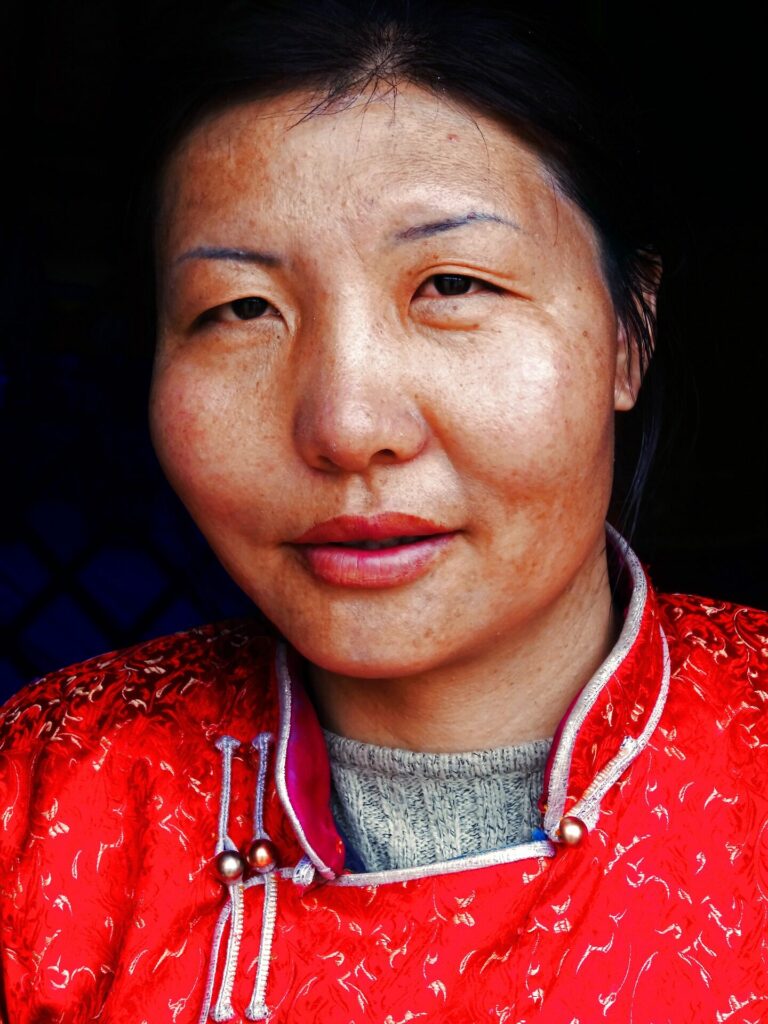
The nomads regard their camels with the utmost respect. Tourists often make the understandable mistake of asking how many camels a family has. This is the equivalent of asking “how much do you earn?” in western culture.
11AM
The guided tour on camelback begins. One nomadic guide usually rides the camel, and is connected to about five or six other camels behind them. The caravan walks calmly and solemnly, keeping parallel to the base of the soaring 200m high sand dunes. In Winter, the nomads would be wearing the traditional ‘deel’, a robe-like garment that goes over the top of your original clothes. The ‘deel’ is made from thick material, comes in a myriad of colours and patterns and is tied across the front with a matching strip of material. The open front design allows nomads to comfortably ride horses and camels.
12PM
The camel caravan will conclude at the base of the sand dune, and tourists have the opportunity to climb to the top for breath-taking views. The nomads have a giggle at the tourists, as they run and leap on the way down the sand dune. Tourist often fall and tumble down the loose, sandy dune. The nomads will then spend some time preparing lunch. Usually meat and dried vegetables are on the menu, and always in large portions.
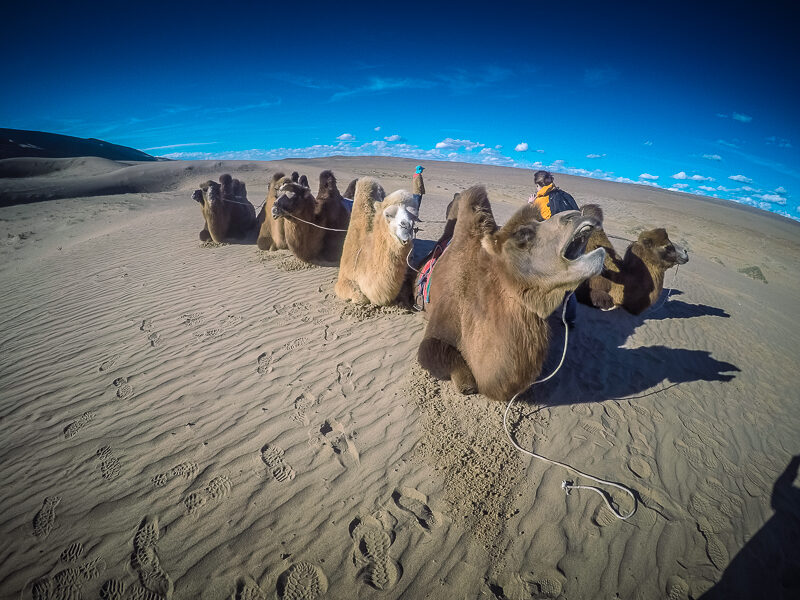
1PM
Nomadic Mongolians living in the Gobi Desert change their locations twice a year, to co-ordinate with the seasons. This move usually occurs in May and October. Time is spent in the lead up to these moves, preparing livestock, packing up their possessions and stocking up on provisions (especially in Winter). The new location is about 50-100 kms away from their original location, and is a place that is sheltered and safer than the Summer locality.
2PM
Time is taken to tend to the animals. This livestock is what the nomadic families rely on for their income and living, so they are well taken care of. Goats are particularly valued for their hair. Mongolia is the biggest exporter and producer of quality cashmere in the world.

The family also prepare some camel milk tea and biscuits to share with the arriving guests. All tea must be sipped with the left hand, and slurping is regarded as polite. The family will also offer new guests some vodka and snuff.
3PM
The nomadic families ride motorcycles to neighbouring ger camps to get supplies. Most families rely on their neighbours (often kilometres away) to share experiences, food and general supplies.
Dinner needs to be prepared for the family and the guests. Dinner usually consists of goat meat, some dried vegetables and pasta. Pasta is a common ingredient, as it’s filling, cheap, and very easy to cook.
6PM
Some time is always out aside in a day to practise religious rituals. In all gers, the family set up their own shrine/alter to worship deities. These are combined with photos of family members. Tibetan Buddhism is a ritualistic religion with a large number of deities and is commonly practised in Mongolia.
Nomads eat dinner as a family. This includes playing cards, drinking tea and vodka, and playing a traditional Mongolian game called Shagai. Shagai refers to the ankle bone of a sheep or goat. The bones are collected and used for traditional games in Mongolia. The bones may be painted bright colours, and are thought to be the first forms of dice. In the game, the Shagai is rolled, and generally lands on one of four sides: horse, camel, sheep or goat. A fifth side, cow, is possible on uneven ground.
7PM
The nomads stoke the fires in all of the gers with dried manure. They then check on livestock to ensure they’re warm and secure. Then, the Mongolians prepare for sleep, to start again tomorrow.
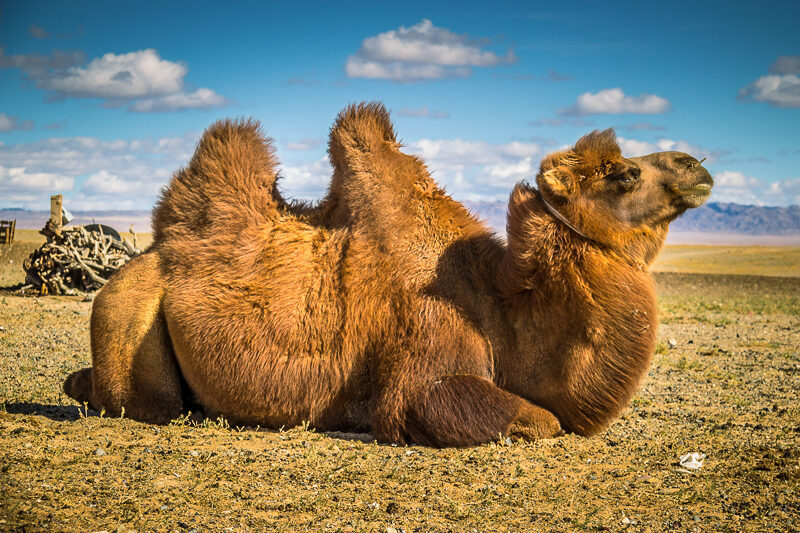
The lives of these fascinating people are so removed from our digital and connected world. Their simplicity leads to a happy life and they take nothing for granted. Why don’t you head into the Mongolian wilderness – watch how it changes your perspectives.
Author: Michelle Hyde
Camel images captured by Ben Fehervary


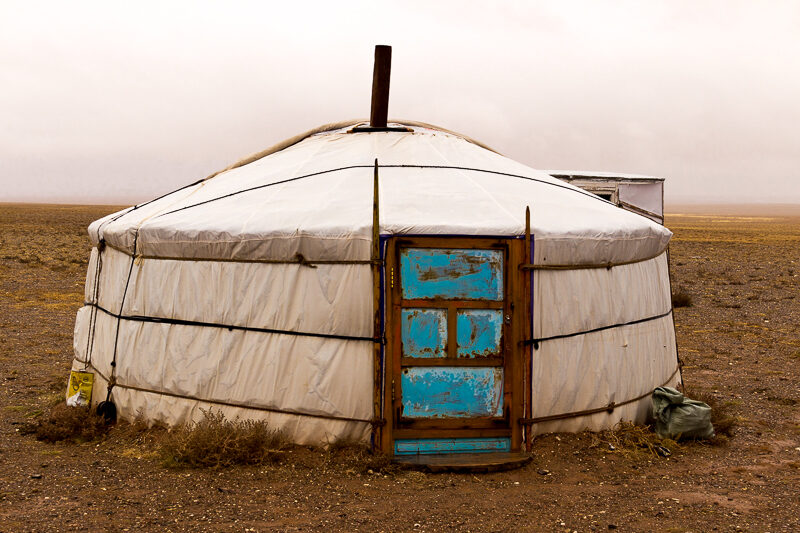
comments
Be the first to leave a comment forA Day In The Life Of A Gobi Desert Nomad